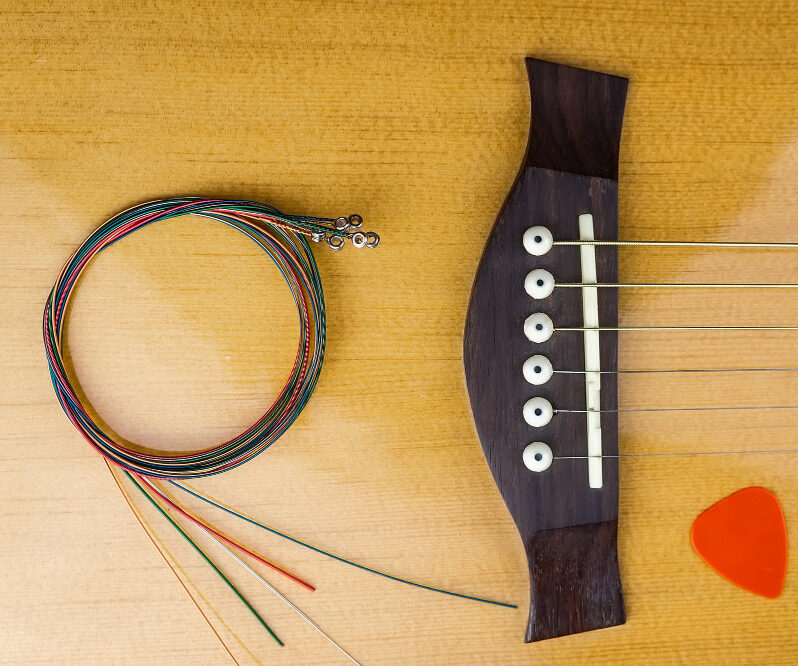For guitarists, strings are more than just metal threads; they’re the very voice of our instruments. Choosing the right ones can significantly impact your playing experience, influencing everything from tone and playability to comfort and musical expression. But with a vast array of string options available, navigating the choices can feel overwhelming. Fear not, fellow musicians! We will answer the question,
How to choose guitar strings?
This comprehensive guide will equip you with the knowledge to select the perfect strings for your unique needs and musical styles.
Understanding the String Universe:
Before diving into specifics, let’s demystify the basic terminology:
- Gauge: This refers to the thickness of the strings, measured in thousandths of an inch (e.g., .009, .010). Generally, thicker gauges create a warmer, fuller tone but require more finger strength, while thinner gauges offer brighter tones and easier playability.
- Winding: Most guitar strings are either plain steel (unwound) for brighter tones or wound with nickel, bronze, or other materials for warmer tones and increased durability.
- Material: Different materials affect tone and feel. Nickel-wound strings offer a balanced tone with good sustain, while bronze provides a brighter, twangier sound often preferred for country and blues styles. Pure nickel offers a smooth, vintage feel.
Matching Strings to Your Guitar:
The first step is understanding your guitar type and playing style:
- Acoustic Guitars:
- Steel-string acoustics require heavier gauges (typically .011-.052) for optimal tension and sound projection. Consider fingerstyle playing preferences when choosing thickness.
- Nylon-string guitars use light gauges (typically .028-.044) for their softer tension and playability. Consider the desired tone (brighter vs. warmer) when choosing material.
- Electric Guitars:
- Electric guitars offer more flexibility in gauge choice. Heavier gauges (.010-.052) suit heavier music styles like rock and metal, while lighter gauges (.009-.042) favor blues, jazz, and funk.
- Experiment with different winding materials and gauges to find your ideal tone and attack.
Considering Your Playing Style:
Beyond guitar type, your playing style plays a crucial role:
- Fingerstyle: Opt for lighter gauges for easier fretting and articulation. Consider materials like silk or coated strings for a smoother, quieter feel.
- Strumming: Heavier gauges provide more volume and projection, useful for genres like rock and bluegrass. Experiment with different picks to further refine your strumming sound.
- Bending and Vibrato: Lighter gauges bend easier, but lose tension faster. Experiment with hybrid sets (mixing gauges) for specific needs.
Additional Factors:
- Tuning: Experiment with alternative tunings (e.g., drop D, open tunings) and adjust string gauges accordingly.
- Budget: High-quality strings offer better tone and lifespan, but cost more. Find a balance between price and performance that suits your needs.
- Environment: Strings can corrode faster in humid environments. Consider coated strings for increased durability.
Beyond the Basics: Experiment and Explore:
Remember, choosing strings is a personal journey. Don’t be afraid to experiment with different gauges, materials, and brands to discover what resonates with you. Listen to your favorite guitarists, try their string setups, and see what works best for your sound.
Bonus Tips:
- Record yourself playing with different strings to objectively compare their sound.
- Ask experienced guitarists or shop staff for recommendations based on your specific needs.
- Don’t be afraid to break the rules! Mixing gauges or trying exotic materials can lead to unique and inspiring tones.
With this knowledge in hand, you’re ready to embark on your string exploration journey. Remember, the perfect string is the one that inspires you to play, create, and share your musical voice with the world! Let the music flow!
Added by
GuitarGaGa
WRITE A COMMENT
WRITE A COMMENT


No comments yet